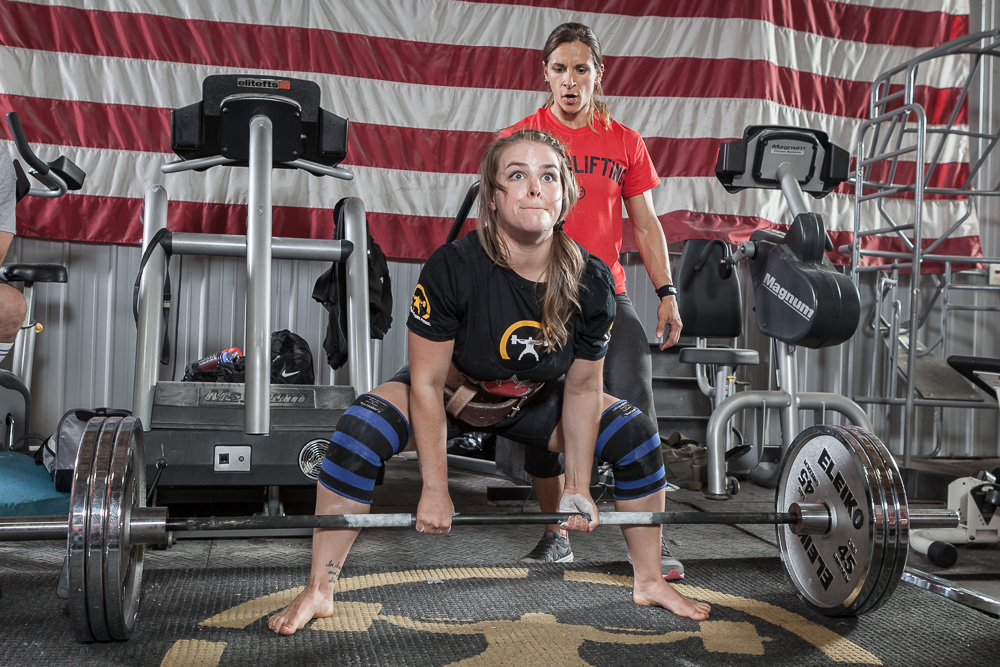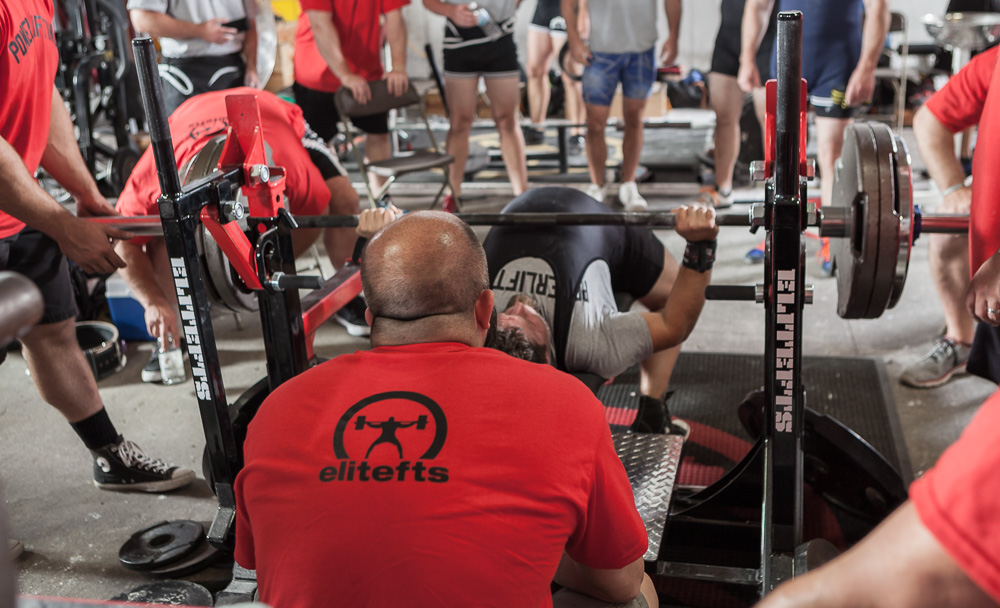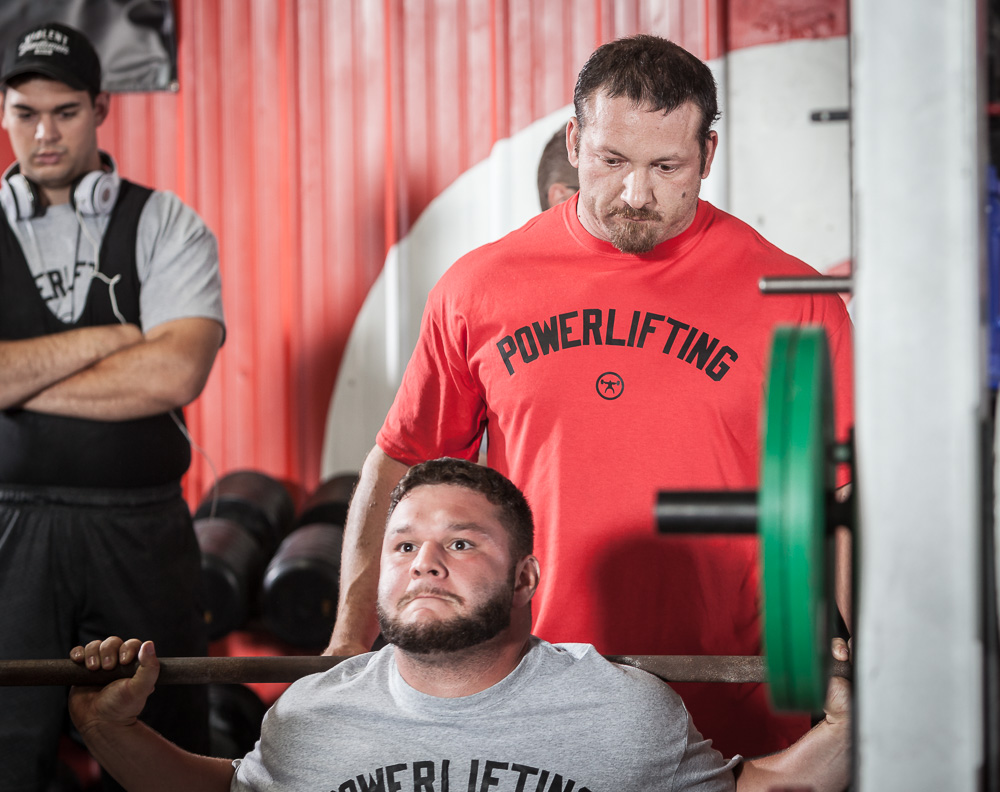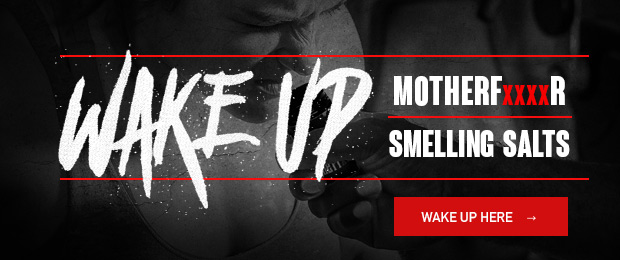
This article will consider the major powerlifting movements and give suggestions for cues and technical adjustments that may prove helpful in both improving strength and prolonging health.
Deadlift
Pulling the Slack Out of the Bar vs. Pulling Yourself Into the Bar
- Pulling slack out of the bar leaves the shoulders protracted, hips high, and shins vertical.
- Pulling yourself into the bar can help create tightness, but doing so encourages lower hips, knee bend, and less shoulder spread.
Depending on the bar you’re using and your strength level, one of two things will happen when you take the slack out of the bar: your position will stay unchanged when the bar doesn’t bend, or you’ll get a little “taller” as the bar bends. Option two is the golden ticket; by getting taller, you’re extending your hips and knees a little more, which in turn means better leverages. Switching to Chucks or other flat-soled shoes might earn you an extra half-inch of bar height, but bending a specialized deadlift bar can quadruple that. That’s almost like turning a deadlift from the floor into a low block pull. If you do this with your scapulae protracted and your upper back flexed, your height advantage improves even more.
RECENT: An Updated Deadlift Cycle for Average Joes
On the other hand, pulling yourself into the bar can do the opposite by encouraging knee flexion and retraction of the upper back muscles. Watch a video of someone pulling themselves hard into a bar and more often than not you’ll see their shoulders pinch and their hips dip. There are some advantages here. First, this can transfer load from the back and hips to the knees, which reduces the force exerted on the spine. Second, this active tensing of the muscles—particularly the lats and scap retractors—also isometrically braces the spine.
The second item is a big selling point for this style, as it makes it hard to accidentally flex the spine during the lift. Compression added to flexion translates into the vertebral discs being pinched under load; when this happens, rather than the entire body of the disc distributing force, the ventral edge absorbs more than the rest. The result can be weakened discs or even a rupture. Back in 1987, Stuart McGill showed in an experiment that the change in shear loading (which is the most worrisome force placed on the spine) that a subject with a neutral spine experienced 200 Newtons of shear, while the fully flexed spine experienced 1900N of shear load. Recent work by Gallagher and Marras indicate that 1000N is the upper safety limit for infrequent shear loads, as might be encountered by a lifter.
For the general athlete or the recreational lifter, keeping the back healthy is priority number one, and pulling into the bar is the easiest method to learn for preventing spinal flexion and keeping those discs happy. For competitive lifters, though, this is a non-starter: the tightness gained doesn’t add to PR poundages the same way gaining height does. Therefore, every competitive lifter is doomed to a life of spinal fusions.
Or not.
What competitive lifters do is create the same tension with little active movement, i.e., it’s almost entirely isometric. The broad principle is the same as pulling into the bar—create tightness—but advanced lifters do this without the training wheels of actively moving themselves closer to the ground. In fact, many create static tension while the bar is actually bending towards them. Most of this is simply a mind-muscle connection thing that can only be learned through practice and coaching, but there are some movement-based tricks that can help.
The first is one you’re familiar with: abdominal bracing. While every lifter has different preferences for how big they want their belly during the deadlift, your preference can be aided by adjusting your belt just barely tight enough to give you tactile feedback on how close you are to an optimal position. Another trick is to help tense your lats by trying to externally rotate your arms while setting up — imagine trying to twist the bar into a horseshoe shape around your legs. Also important is that the spine likely adapts to pressure, as seen when elite lifters demonstrate significantly higher levels of bone density than non-lifters.
General athletes are probably advised to use the “pull into the bar” technique to increase sport specificity and reduce injuries; bodybuilders can go either way, since the stimuli are different for the involved muscles, especially the upper back. Competitive powerlifters should learn to tense without using the bar or as part of taking the slack out; I also think the technique is easily learned to the point that gym enthusiasts should learn it, too.
Bench Press
Extreme Arch vs. Mild Arch
- Arching reduces the wear on the shoulder and can improve lifters’ leverages, but greater arching can lead to pain and spine issues.
The bottom few degrees of shoulder rotation on the bench press can be a real killer. There’s reason to think that’s where most of the damage to the shoulder occurs, and it’s almost always the position that leads to strained pecs and sore shoulders. Reducing the range of motion to eliminate this last bit of movement is an easy way to stay healthier and add some pounds to the bar. While boards and pads are both great options, the one available to just about anyone is arching the back.
And since a little bit of arch is good, more is better, at least in terms of certain levers. For example, the huge arch demonstrated by some professional lifters advantages the triceps, though the reduced range of motion removes the pecs and limits the ability of the delts to assist in the load. Bench press technique—including the high arch—has evolved to make the lift triceps-dominant, anyways, so this isn’t much of a consideration, especially for geared lifters.
Aside from the hyper-specificity of the high bench arch making it unappealing to physique enthusiasts and general athletes, this competition-style arch has health risks. At the very least, it often leads to lingering back pain, likely from the compression of nerves exiting the spine (herniated discs, fractures, and bone spurs would be more severe causes.) You’re likely to hear that a good bench set up is supposed to be uncomfortable, and an achy back is a big part of that. Another McGill study noted that the prone “Superman” exercises performed on the floor create as much as 6000N of force, or roughly 1300 pounds of spinal compression. The positioning of this exercise is relatively similar to a moderate bench arch, and as it doesn’t involve leg drive or pushing the traps/upper back into a fixed bench, I wouldn’t be surprised to find that hardcore archers create even more compression. Now, this isn’t as much of an issue just looked at as a number—a competition squat or deadlift can create over 20,000N of compression, and computer models have shown a six-foot person can create 10,000 N with a 300-pound deadlift—but the extreme arch creates shear forces.
WATCH: Tuning the Human Body for Performance: A Conversation with Dr. Stuart McGill
Perhaps more importantly, if one vertebral segment is extended to a greater degree than its neighbors (i.e., rather than creating a smooth curve, the arch is obtained with one segment hinging) the risk goes up dramatically because you’re essentially creating a “weak link” in your spine. Rolling over a pipe, foam roller, or a thick medicine ball might help alleviate hinging by freeing up other segments to accommodate more of the arch, though that’s a hunch on my part more than anything. My guess is that this technique is largely self-regulating so that as long as your arch is relatively pain free, you’re probably safe to keep using it without trouble. If you can’t arch without pain, a device like the Shoulder Saver is the way to go. Bodybuilders should take note, though, that there is a reduction in pec stimulus with any form of arching.
Squat
Low-Bar, Ultra-Wide Stance and Sit Back vs. High-Bar, Slightly Beyond Shoulder-Width with Shin Angling
- Power-style squatting can improve leverages and stretch-shortening cycle (and material stretching in geared lifters), but can also create knee valgus and hip pain, and leads to greater spinal loading.
Many of the same spine factors apply to the power-style squat as with the bench and deadlift, though to a lesser degree, since it’s much harder to complete a squat with bad form than it is with a deadlift — the scared-cat back generally leads to a bar dump. So instead of rehashing the spine stuff, I want to talk about the legs. An ultra-wide, low-bar, sit-back style of squat is generally preferred by most competitive lifters, especially ones who compete in geared meets. The leverages are better and it takes full advantage of the stretch-shortening cycle. The biggest requisite for the style is having enough glute, hamstring, and groin muscle to create a massive elastic rebound when stretched. The same stretch also takes full advantage of squat suits and briefs.
Most ultra-wide squatters have to come to terms with hip pain, particularly around the frontal hip crease and along the sides radiating down the side of the leg. It’s just part of the territory. Not squatting low can help, as can training in briefs or even a suit. Assuming the pain is muscular, stretching, mobilizing, and rolling the hip flexors and lateral thigh muscles can help. If it’s structural, i.e., your hip joint isn’t open enough to accommodate the stance, then there’s not much you can do. That’s just ball-on-socket grinding, and short of radical surgery (or developing ligament laxity) there’s not much to do about it. Honestly, the safe option might be abandoning the style completely.
More theoretical is what can happen to the knee in ultra-wide stances. While it’s not a coached technique, the knee can stray inward away from the foot into valgus. Mild valgus is actually pretty common during big lifts even of the narrow-stance variety; I’m actually more worried about extreme valgus as it occurs at the bottom of the squat. Because one of the biggest ultra-wide coaching cues is “knees out” and the practitioners spend a great deal of time performing lifts that strengthen the leg rotators, I imagine most cases of this are related are purely structural; basically, lifters position their feet wider than their hips want to open and rotate. This forces the knees in and the feet to pronate, which exacerbates the issue.
Because these angles can place a great deal of stress on the knee, especially the ACL, it’s probably smart for most people to avoid the position altogether. An easy visual cue is to make sure that at the bottom of the squat your knee stays over your foot when viewed from the front. If you’re having problems achieving this but don’t want to bring your stance closer, make sure your feet are rotated out so that they’re in line with your thighs. Knee wraps on heavy attempts might also help by easing the transition out of the hole, as would briefs and suits. Finally, plenty of big squats of occurred without going ultra-wide, including world records. If you’re not built for them, don’t feel like you won’t reach your potential in the lift.
For athletes, I really only recommend the powerlifting-style of squat for hamstring development, and then mainly for trainees who don’t spend much time jumping. The more experienced your athlete (e.g., juniors and seniors in college, or healthy professionals) the more I’d feel comfortable with including the technique. Bodybuilders looking to build the inner-thigh and back of the legs can give it a whirl, but keep it balanced so that the quads don’t look disproportionately small by comparison. Recreational lifters are free to try it as part of Westside-style programming, provided your knees are healthy and you avoid routine valgus — just listen to your body and take care of your hips.
Recommended Reading
- Gallagher and Marras: “Tolerance of the lumbar spine to shear: A review and recommended exposure limits.” Clinical Biomechanics , Volume 27 , Issue 10 , 973 – 978.
- Leland, Tony: “Biomechanical Analysis of the Deadlift.” Accessed 2016.
- McGill, Stuart: Lower Back Disorders, 3rd edition. Human Kinetics Press, 2015.













